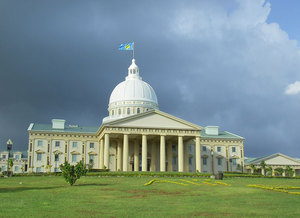Palau - a brief history
The Republic of Palau comprises the most western of the Caroline Islands in the north-west Pacific. Ancestors of the present Caroline Islanders are thought to have come from Southeast Asia between 3,000 and 4,500 years ago. Archaeological evidence confirms the existence of early specialised shell and stone technology and extensive agricultural terracing.
Early colonisers
As with its neighbouring island states of the Marshall Islands and the Federated States of Micronesia, Palau’s first colonisers were Spanish, who called the islands Los Palos. One European ship visit attached much attention: the British ship Antelope was wrecked on an island in the group and the encounter led to the introduction of a chief’s son, Lee Bo, into fashionable London society.
Spain maintained its sovereignty over the islands until Germany purchased them in 1899.
Then at the start of World War I in 1914, Japan took over the Carolines. As a Japanese colony, Palau gained a modern infrastructure and an expanded copra industry. By 1935 one of the most populous islands, Koror had more than four times as many Japanese in the population as locals.
World War II and the aftermath
Palau became a significant military base during World War II. Its proximity made it a convenient launching pad for Japanese attacks on the Philippines. Following US military rule at the end of the war, in 1947 Palau became part of the US-administered Trust Territory of the Pacific Islands (TTPI). Independence, however, was still a long way off and was achieved many years later than it was for Palau’s Micronesian neighbours.
Bitter security differences with the United States
The Republic of Palau adopted a nuclear-free constitution in 1981, but this delayed for some time agreement with the United States on a mutually acceptable Compact of Free Association. Washington considered the nuclear-free provisions to be incompatible with American security interests.
Eventually, in 1986, a draft Compact was agreed with the United States that gave the islands independence subject to defence being the responsibility of the United States for 50 years. But successive referenda in Palau failed to produce the required 75% vote in favour of the Compact. In 1987 Palau voted to amend the constitution to allow approval of the Compact by a simple majority. In a subsequent plebiscite, 73% supported the draft Compact. However, the Supreme Court ruled in 1988 that it was unconstitutional.
This was one of the more troubled periods in Palau’s long experience of colonial rulers. There was pressure from Washington and, in Palau itself, unprecedented political scandals involving even murder and suicide. Eventually Washington’s concerns were met and this resulted in Palau achieving self-government in free association with the United States on 1 October 1994.
The economy – and unusual income sources
The country’s economy continues to consist largely of subsistence agriculture and fishing, with increasing revenue from tourism. In 2009, Palau announced it would accept 17 of the remaining Uyghur detainees in Guantanamo. It had been asked to do so by the United States and received substantial financial recompense. China's angry reaction was ignored by Palau which remains one of the diminishing number of states that accord full diplomatic recognition to Taiwan.

Government buildings in Melekeok, Palau